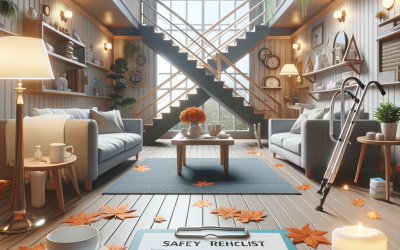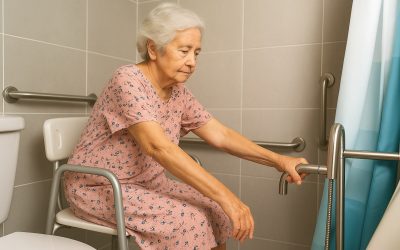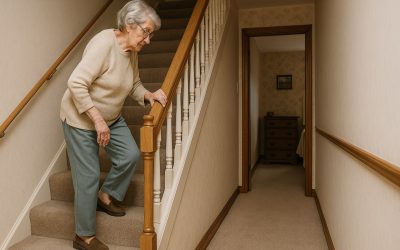As we age, maintaining the safety and accessibility of our homes becomes increasingly important. Ensuring that our living spaces are free from hazards can significantly reduce the risk of falls, a common and serious concern among seniors. In this comprehensive guide, I’ll share practical tips and actionable advice for making your home a safe haven using essential fall-prevention strategies.
Understanding the Importance of Fall Prevention for Seniors
Falls are a leading cause of injury among older adults, often leading to severe consequences. A proactive approach to fall prevention can help maintain independence and improve quality of life. Understanding the unique needs of seniors allows us to create environments that foster safety and peace of mind.
Essential Home Fall Prevention Tips: Proven Safe Steps
1. Conduct a Thorough Home Safety Checklist
Before making any changes, assess the current state of your home. A comprehensive safety checklist can help you identify potential hazards. Consider these key areas:
- Lighting: Ensure all areas are well-lit, especially staircases and entryways.
- Floors: Secure loose rugs and remove clutter.
- Bathrooms: Install grab bars and non-slip mats.
2. Improve Lighting and Visibility
Poor lighting increases the risk of falls. Seniors may experience reduced vision, making it crucial to enhance visibility throughout the home. Install bright, energy-efficient LED bulbs and consider motion-sensor lights for added convenience.
Product Evaluation: Lighting Options
| Product | Pros | Cons |
|---|---|---|
| LED Motion-Sensor Lights | Energy-efficient, easy installation, enhances safety | Requires regular battery changes |
| Smart Lighting Systems | Remote control options, customizable settings | Higher upfront cost |
3. Secure Floors and Walkways
Slip-and-trip hazards can be mitigated with simple modifications:
- Remove or tape down loose rugs.
- Rearrange furniture to create clear paths.
- Use slip-resistant mats in high-risk areas such as the kitchen and bathroom.
Essential Home Fall Prevention Tips: Proven Safe Steps in the Bathroom
The bathroom is one of the most common places for falls. Implement these steps to enhance safety:
- Grab Bars: Install them near the toilet and in the shower.
- Raised Toilet Seats: Easier access reduces strain.
- Non-Slip Mats: Essential for reducing slip risks.
4. Install Assistive Devices
Assistive devices offer additional support and stability. From handrails on stairs to walking aids, these tools can significantly reduce the risk of falls.
Pros & Cons: Assistive Device Options
| Device | Pros | Cons |
|---|---|---|
| Grab Bars | Increases stability, easy to install | Requires drilling |
| Walking Aids | Improves mobility, various options available | May need personal adjustment |
5. Encourage Regular Exercise
Strengthening exercises and physical activity are crucial for maintaining balance and flexibility. Encourage seniors to engage in activities like walking, yoga, or tai chi, which can be adapted to their fitness levels.
Creating a Custom Home Safety Checklist
Each home is unique, and creating a customized safety checklist ensures you address specific needs. Consider these factors:
- Frequently Used Areas: Pay attention to high-traffic zones.
- Personal Needs: Adapt changes to fit individual mobility levels.
Understanding the Role of Family and Caregivers
Family members and caregivers play a vital role in fall prevention. Regularly monitor changes in mobility, and encourage open communication to address concerns swiftly. Collaborative efforts create a supportive environment for seniors.
Common FAQs About Fall Prevention for Seniors
- What are the most common causes of falls in seniors?
Impaired vision, slippery surfaces, and poor lighting are major contributors. - How often should a home safety assessment be conducted?
At least once a year, or whenever there are significant changes in living conditions. - Can assistive devices be covered by insurance?
Some assistive devices may be covered, but it’s best to check with individual insurance plans. - Are exercise programs specifically designed for seniors?
Yes, many community centers and gyms offer senior-focused exercise programs. - How can technology be used in fall prevention?
Smart home devices and personal alert systems can enhance safety and provide immediate assistance if needed.
Taking proactive steps to enhance fall prevention not only protects our loved ones but also instills a sense of independence and confidence. By integrating these strategies into your home, you’re creating an environment where safety thrives. Remember, it’s the simple adjustments that often make the biggest difference. Stay safe, stay vigilant, and above all, stay connected with those who matter most.




0 Comments